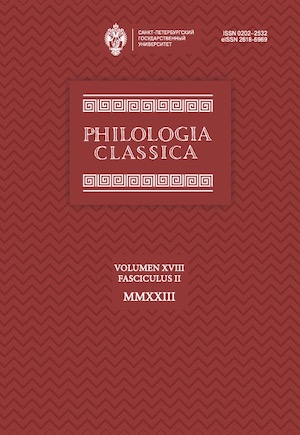What is a γρυπαίετος (Aesch. Fr. inc. fab. 422 R. )?
DOI:
https://doi.org/10.21638/spbu20.2023.203Аннотация
Цель данной статьи — определить, каким мифическим существом был эсхиловский γρυπαίετος («грифон-орел»), вызвавший такой скандал у Еврипида в «Лягушках» Аристофана 928–930 (= Aesch. fr. inc. fab. 422 R.). Этот термин обычно интерпретируется в трех вариантах: (а) как поэтическая форма «орла»; (б) как поэтическая форма «грифона»; (в) как «орел породы грифонов». Свидетельства «Лягушек» Аристофана и вазовой живописи позволяют предположить, что это мог быть идиосинкратический, архаичный вид грифона, называемый современными специалистами «грифоном-птицей» и характеризующийся наличием двух, а не четырех ног и телом птицы, а не льва. Это фантастическое существо довольно часто появлялось на архаических чернофигурных вазах в Афинах, но полностью исчезло к концу VI в. до н. э. В связи с этим его внешний вид должен был быть неизвестен публике Аристофана, что делает невозможным понимание термина γρυπαίετος (Ra. 930). Поэтому в данной статье высказывается предположение, что эсхиловский γρυπαίετος («грифон-орел») — это сказочное животное, состоящее из частей грифона и орла, как следует из названия: голова грифона (с открытым крючковатым клювом, длинными заостренными ушами, выступом или рогом над глазами и завитком или плюмажем, спадающим на одну сторону шеи), венчающая тело орла (двуногое, пернатое, с крыльями и когтями).
Ключевые слова:
Эсхил, Аристофан, грифон, γρυπαίετος, грифон-орел
Скачивания
Библиографические ссылки
Загрузки
Опубликован
Как цитировать
Выпуск
Раздел
Лицензия
Статьи журнала «Philologia Classica» находятся в открытом доступе и распространяются в соответствии с условиями Лицензионного Договора с Санкт-Петербургским государственным университетом, который бесплатно предоставляет авторам неограниченное распространение и самостоятельное архивирование.






